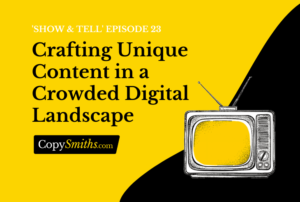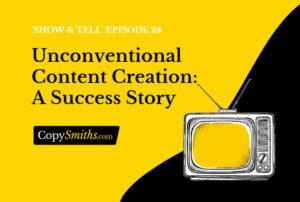Home » Content Marketing » Content Ideation: Clear Steps to Help You Get Started Today

Content Ideation: Clear Steps to Help You Get Started Today
Content ideation can sometimes feel complicated and stressful. How do you continuously come up with great ideas on topics in your niche to attract audiences?
How do you ensure that your content remains captivating, compelling, and converts readers?
Answering those questions must already feel like a challenge before you start ideating. But it doesn’t have to be one. There are actions you can take today and turn into part of an effective content creation routine.
Here are four steps that will help you get started with content ideation as soon as you implement them.
Step 1: Goal Setting
The first step, for any project that you want to succeed, is planning and determining your goals. You and your content team need to know what the purpose of the content you create is. You need to determine how it:
- Adds value to your brand and website.
- Fits into your marketing strategy to convert your audience into customers.
Goals play a major role in content ideation by helping to determine what type of content you create.
The content you’ll eventually create can have different goals such as:
Increasing or Bringing Awareness to Your Brand
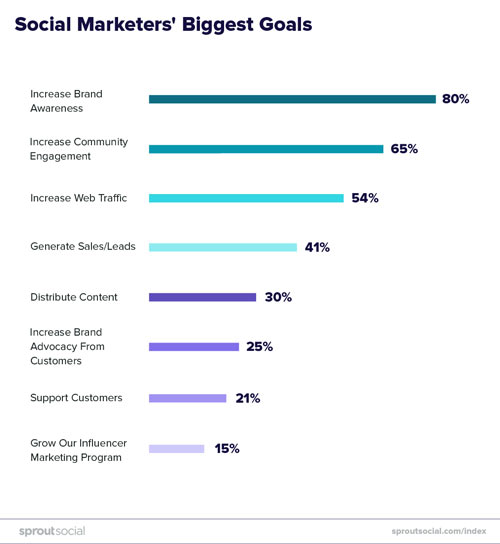
Source: sproutsocial.com
This is the primary goal for all content, to be honest. Sprout Social’s 2018 Index found that brand awareness is the priority for marketers.
Brand awareness is the reason why you can find almost all information on the internet. Everybody is trying to showcase who/what they are and what they have to offer.
Every brand is fighting for attention and content that increases brand awareness is how they do it. It’s how customers discover and remember you, and the more awareness, the:
- Larger your share of your niche market.
- Better your chances of making a sale.
If brand awareness is your only goal, then you can think of content ideas for:
- Guest posts on popular blogs.
- Micro-content like infographics, checklists, and more…
- Social media promotion.
- Partnerships with popular brands and influencers.
- Referral programs.
Highlighting Problems
Most long-lasting businesses have figured that the key to longevity is problem-solving. You have to continuously offer solutions to your audience and to do that, problems have to be evident.
If this is your goal, then your content is centered around solving problems for your audience.
In such cases, your content ideas can include:
- Articles that ask a question at the very start.
- Interviews with customers that give a good review of how you solved their problem.
- Polls or surveys to find out what your audience really needs.
- Promotion of your product or service by relevant niche experts.
Step 2: Content Strategy
Once you have identified your goal, it’s time to plan your content strategy.
Here’s what you need to determine:
- What type of content resonates best with your audience?
- Which platforms should you use to share the content?
- What are your content’s key performance indicators?
- Who forms your content team?
- When should you distribute your content?
Types of Content
There are many different forms of content you can choose from. Some are long-form and others are micro-content you can publish widely.
Long-form content can include:
- Pillar pages with all of the information on a general topic.
- Guest posts on other blogs to get you noticed.
- In-depth articles on a specific topic.
Micro-content is crucial to your content strategy. You want to make sure you’re present whenever online users need content. To do this create pieces of micro-content to share on hundreds of different platforms.
These bits are taken from long-form content like pillar pages. They can include:
- Checklists
- Short videos
- Infographics
- Slideshows
- Tweets
- Memes
- Articles
- And much more…
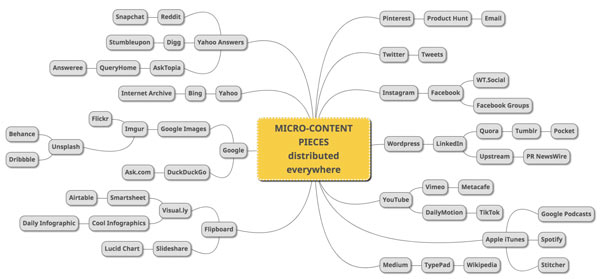
Platforms
The internet is filled with places where you can share your content. Different people prefer consuming content in different ways. It’s best to use as many relevant platforms as you can. The more popular platforms include:
- Social networks (Facebook, Twitter, LinkedIn, Pinterest, YouTube, Instagram, etc.)
- Websites and blogs dedicated to your brand.
- Online stores to sell your products or services (Amazon, Alibaba, etc.)
- Your website’s email list.
Key Performance Indicators
You need to identify what will make your content successful and whether you’re getting a good ROI. Establish which metrics you will judge your content on.
Key content metrics include:
- Lead quality: Your reader is a qualified lead if they engage with you after consuming content.
- Site Traffic: This determines whether your content is attracting page visits.
- Social Media ROI: It’s important to know if your brand is relevant and getting mentioned. You should also determine which social networks work best for you.
- Bounce Rate: This measures how much time your audience spends on your site. You want to keep them there as long as possible, going through other content or making a purchase.
- SEO Performance: You want to know where your content ranks on search engines.
- Sales: Is your content leading your audience all the way through the sales funnel?
- Authority: Content is meant to establish you as an authority in your field. The more people consider you an authority, the more they’re likely to trust your brand.
Team Selection
When you begin the content creation process, you’ll realize you need a team of experts to get it right. A lot goes into creating content, and so you need to figure out:
- How big will your team be?
- What will each member be responsible for?
- What will you take charge of?
You also need to determine whether you want a team of people:
- With multiple talents.
- With a single, strong talent each.
Your team can comprise of:
- Writers
- Web developers
- Videographers
- Graphic designers
- Editors
- SEO experts
- And more…
Editorial Calendar
Creating content also means knowing when to publish it. Consistency is key to remaining relevant so it’s best to follow a timeline. Set deadlines for each of your team members to meet with each new piece of content.
You can come up with different kinds of templates, but generally, they’ll all include:
- A publishing date.
- A headline or topic for your content.
- Who’s responsible for creating it.
- Who’s assigned to supervise that it gets published.
- Regular updates to determine which stage it’s at.
Step 3: Research
One of the most obvious steps to coming up with ideas is doing the research. You have to focus on two key types of research for great content ideation:
Audience Research
The content you create needs to be relevant to your targeted audience. You have to ensure that it’s what your readers want and it fits your niche. To ensure this is the case, you have to:
- Establish the audience’s pain points. You can engage with your audience directly, asking them for information. Ask them to fill surveys, post polls on your social media, send emails, and study your niche.
- Define your value proposition for your audience and how your business solves problems. What makes your offer stand out from your competitors? What gives your audience a reason to choose you?
- Break down your target audience based on the different:
- Buyer personas
- Stages of the buyer journey
Buyer personas consist of the different demographics you obtain from your customers. This information can include:
- Gender
- Age
- Education
- Particular pain points
- Search habits
- Job type
The buyer journey has three distinct stages:
- Awareness: A realization that they have a need to be filled, but aren’t sure how. Micro-content can help create awareness.
- Research: They start looking for solutions to their problem. This is where they look for in-depth content.
- Purchase: They’ve considered all their options and have made a decision on a solution.
Content Research
This research tells you what type of content will likely work for your audience. You can find hints by looking at:
- What topics are trending on social media and search engines for your niche.
- What thought leaders in your field are addressing through their content.
- What’s being discussed in online forums.
- What content is working for your competitors.
- Which keywords you should be using in your topic ideas.
Once you have this information, create content ideas around it and give it your own unique twist. Come up with ideas that are better than your competition’s.
Step 4: Content Ideation
Now it’s time to come up with clear content ideas. This is where you combine all the information you’ve gathered in previous steps:
- Specific goals
- Types of content you can create
- Places where you can share it
- Content metrics
- Publishing timeline
- Research
Two great ways of ideating content at this stage include:
Brainstorming
Start by allowing your team to suggest any ideas they have. You want as many ideas on the table as possible, no matter how crazy they might sound.
Don’t reject crazy ideas or ones that don’t seem like they’ll work. There’s no such thing as a bad idea here. Instead, try to build on whacky ideas with your team. Everyone can take turns suggesting what could be added to each of the many ideas.
After you’ve added to ideas, see if you can combine or develop some of them to create one brilliant idea.
Mind Mapping
This technique involves some brainstorming, but it offers greater visualization.
You can mind map on whiteboards, paper, or use one of many visualization tools, including:
- Sketchboard
- MindMaster
- Canva
- GitMind
- And more…
Mind mapping is great because it allows you to easily repurpose smaller ideas into micro-content. You can create an outline for your long-form content and then break it down into useful pieces.
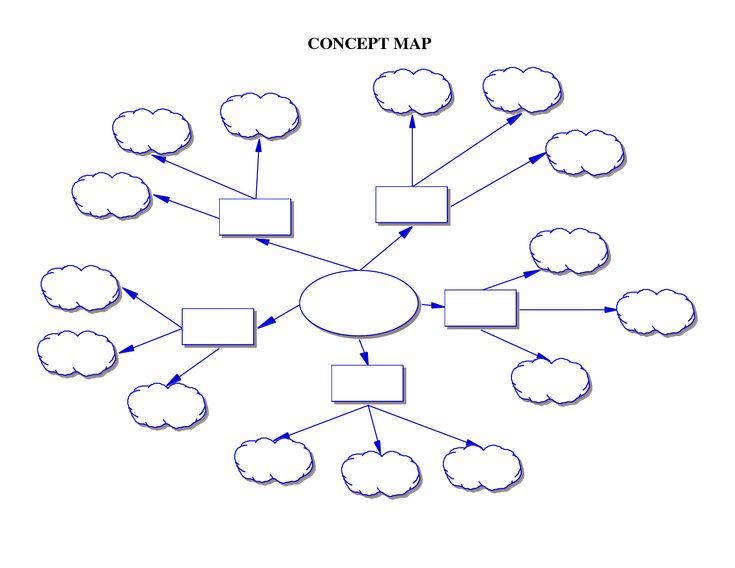
Image courtesy
Get Your Content From the Experts
Creating useful content that drives traffic may seem like a long process. But you don’t have to worry about ideation or creation if you outsource your content to professionals.
Find out how you can focus on other parts of your business and stop worrying about content today.
CopySmiths
I'm Katrina McKinnon, founder of CopySmiths and Small Revolution. In my 20 years of experience, I have helped online businesses create high-performing content specifically on an eCommerce store's blog. Find me on LinkedIn and Twitter.
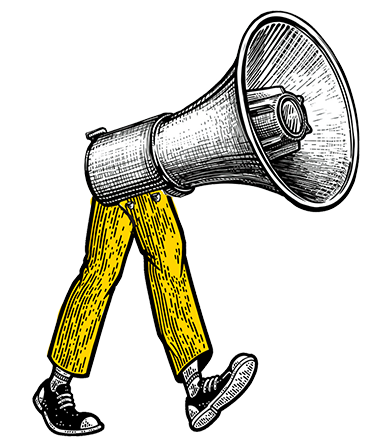
CopySmiths offers the best blog writing services for online stores.
If you'd like us to write blog articles for you, click here.
Most Recent
- 3 Bold Questions You Should Ask When Hiring A Content Writer

- 5 Practical Reasons You Should Use a Blog Post Template

- 4 Amazing Benefits of Using a Title Generator for New eCommerce Blogs

- 10 Awesome Bio Examples Your Online Store Blog Should Emulate

- 8 Basic Steps to Successful Content Development Every Time

Podcasts
Got a question?
Ask our friendly team about our article writing services.
Subscribe to CopyZine
Monthly, hand-picked stories of the best in eCommerce Content.




